 Japan (1855-1877)
Japan (1855-1877)
35+ ships
Definition: The arrival of Perry’s ships in 1853 quickstarted a serie of events called the “Bakumatesu” era, literraly “the end” of Japanese isolation on the International scene. This also comprised the Boshin war. The “Meiji era” is the little-known early era for the fledging Imperial Japanese Navy. Yards were being constructed, academies funded, Western advisors came, Western influence and officers exchanges began. The Boshin war was interesting on the naval point of view in the context of a bloody civil war, almost in the scope of the American civil war, but on the issue over which, the Daimyo or the Emperor, the old and new Japan, would rule the Islands. The first Japanese ironclad was in fact, a former confederate ship…
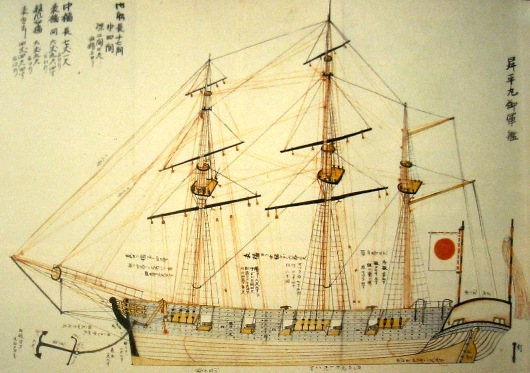
Shoei Maru
明治時代 Meiji-jidai is generally believed to last between 1868 and 1912. Since the WW1 fleet and ships from the 1894 and 1905 battles periods will be covered, i’m focusing here on the first industrial era japanese warships, those of the Boshin war and subsequent industrialization of Japan.
The arrival of Commodore Perry (1853)
Before this earth-moving event, Japan was living the two centuries-long medieval era of Edo (1603–1868). The last period, called 幕末 bakumatsu, immediately preceded the Meiji era. Called “the end” it started with the arrival of the American admiral Perry in 1853, which forced Japan to open to foreign trade, under the threat of modern guns. Before that, foreigner sailors that were stranded to Japan were emprisoned or executed without trial. That became more common with increasing whaling activities and the China trade. Foreigners at least expected assistance or beter, a base for supply.
Japan position hardened after the arrival in 1808 of the British frigate HMS Phaeton, their demands judge “too agressive”. From then, lenience towards “Western barbarians” was brushed aside and in 1825 and edict was passed to use cannon to repel any foreign ship on coastal areas. This caused further troubles when the USS Morrison was found in Kagoshima Bay, and hammered without mercy by artillery. The ship, under Charles W. King in 1837, survived and went back to the USA but the incident was not forgotten. Two years later, Tokyo bay was surrounded by forts and artillery. It should be an error to consider the japanese were not open to modern artillery. Indeed, Nagasaki-based Takashima Shūhan (domain) managed to obtain weapons through the Dutch at Dejima, such as field guns, mortars and firearms. “students” were invited to study Western guns, especially after the British victory in the 1840 Opium War. There was a debate over modernizing the Japanese army with foreign armament to better repel these or to reinforce the army with traditional ways. However after 1840, traditionalists prevailed and Students of Western sciences were accused of treason.
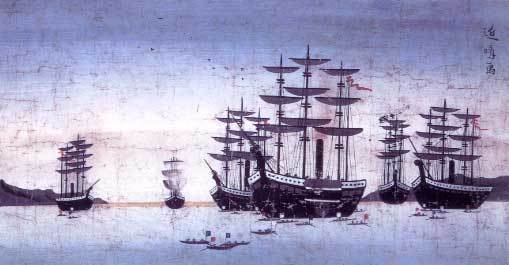
In July 1853 Commodore Matthew C. Perry’s squadron arrived in Edo bay with four mixed frigates. If it was not the “discovery of devils’s ships” as often caricatured in the West (Western industrial ways were known), the force was strong enough to intimidate officials. To back his claims of establishing a treaty, Perry bombarded several building with this brand new Paixhans incendiary shells, creating havoc. After this event, it was decided to built fortifications at Odaiba in Tokyo Bay, and more importantly a reverbatory furnace was established by Egawa Hidetatsu in Nirayama to cast modern cannons, which plans were obtained from the Dutch. Same, soon plans were aso obtained to built a modern warship. This was the beginning of the new Japanese fleet, still until then comprising a wide array of “Fune”, traditional boats propelled by rowers and lattice sails, some armed with traditional bronze muzzle-loading cannons or even wooden cannons, which formed the bulk of coastal defences.
To this isolationist foreign policy known as “Sakoku”, succeeded a period of troubles, as the traditional Tokugawa shogunate order was shaken to its very base. Part of the Japanese people (especially low ranks, besides the Samurai order and nobility) were particularly driven to promising social progresses that went together with the novelties bring by the West, soon inundating the markets.
The first Japanese ships
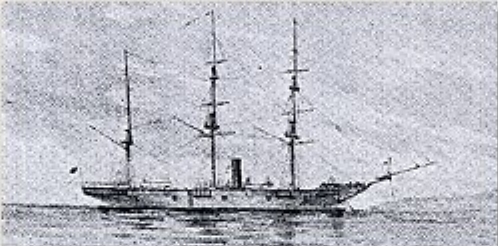
Kanrin Maru, 1858. She was the first Japanese modern, mixed ship (screw-propelled, composite hull).
As there was no centralized power in japan, the first modern ships were attached to local regions making allegiance to the Daimyo (first) and the Emperor. The Daimyo back then controlled about 240 clans which each had their own coinage, customs, administrative laws, army, and navy. For costly, modern ships to be built, they had to be attached to a more centralized power. By law, the Daimyo, which retained all power while the Emperor only had an honorific role, imposed a status quo, which traduced by the strict limitation to ships less than 50 tons. Tis prevented a possible takeover by one of the clans and prevented off-shore operations and travels. What caused the civil war was the hiatus between a rather sympathetic Shogunate to Western influence and an Imperial clan backed by traditionalist and nationalist forces. The civil war lasted one a half year (27 January 1868 – 27 June 1869), seeing both clans mustering many industrial-era ships. Here are these forces:
Japanese ships of the Boshin war (1868-69)
Ironclad ram Kotetsu (1863)
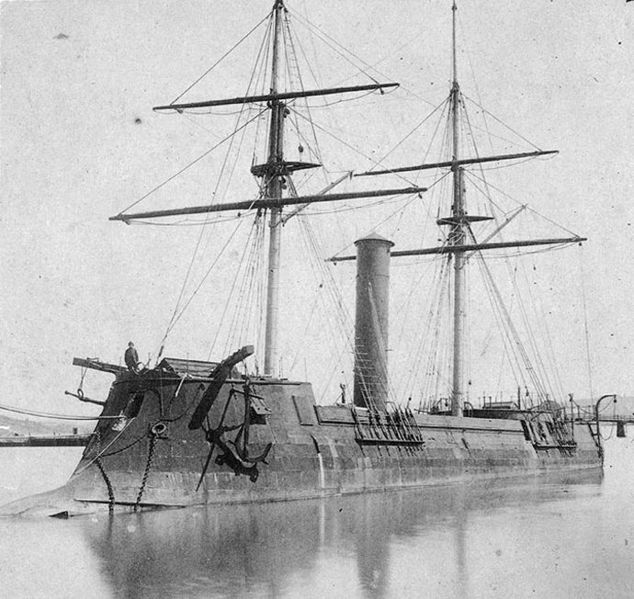
The story of this ship is linked to civil wars: Secession war first, as she was ordered by the Confederacy to the French government, and the Japanese Boshin War a few years later. Originally John Slidell, the confederate commissioner in France approached the French government about the possibility of obtaining sea-going armoured warships in order to dent the Union blockade, in 1863. However French laws prevented, like in UK, any military aid to any belligerent, so through Confederate agent James D. Bulloch compromise was found and the Arman brothers yard in Bordeaux was secretly approached to built a ship fit for the confederacy.
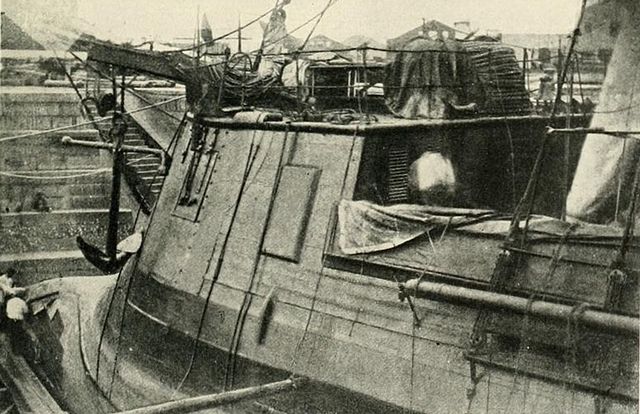
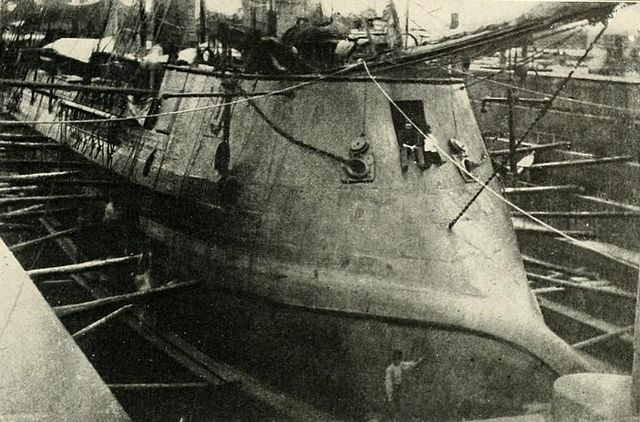
CSS Stonewall in construction at Arman bros. Bordeaux.
Lucien Arman was indeed a personal confidant of Napoleon III. Secret was present in their names (Cheops and Sphinx) while the guns were ordered in UK. However just prior to delivery a Union shipyard clerk denounced the deal at the U.S. Minister’s office in Paris and the government had to block the delivery. Arman obtained however the right to reold the pair to Denmark and Prussia, then opposites in the Schleswig war. The latter Kheops was renamed Prinz Adalbert, and Sphynx became Stærkodder. As the ship was to be delivered to Denmark, disputes erupted over the prices and other issues and negociations failed.
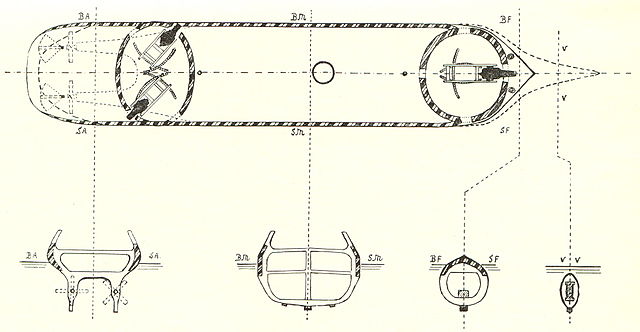
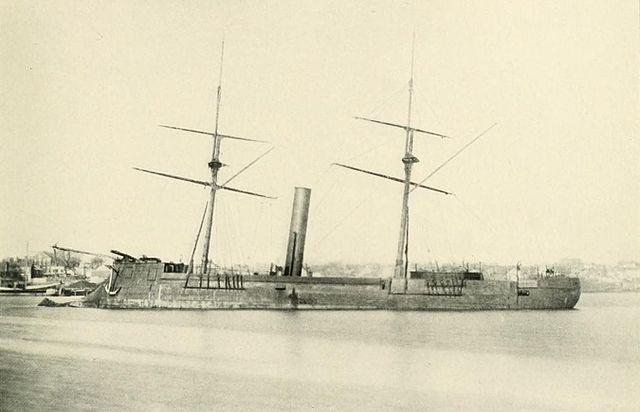
Schematics of the ship and view as completed in Bordeaux, waiting for her Danish crew.
Arman was found with an unsold ironclad. Eventually the ship joined Denmark in 1865 and there, the vessel took on a Confederate crew at Copenhagen and was renamed CSS Stonewall at sea while en route to America. A chase started, as American ships were soon warned about the new “dreaded” ship, for which the Union had no equivalent. Several ships, including the USS Kearsarge and USS Sacramento tried to catch her. She resupplied in Britanny, and joined Spain for repairs after a severe leak was found. Repairs were performed from January to March and on March 24, she was back at sea. Union ships never deared to approach her. She steamed for Lisbon to take on the shortest route for the American coast, reached Nassau on May 6, and then Havana, Cuba, however the capitulation was signed at Appomatox before she arrived. She was turned over to the Union, paid for, then stored to be resold to Japan.

Kotetsu – Fall of the Samurai extension
Her second career started. Renamed Kōtetsu she was supposed to be delivered to the Tokugawa shogunate in 1868, paid before sailing US$30,000, the remainder to be paid on delivery. When the Boshin War started because of neutralilty delivery of Kōtetsu to the shogunate was suspended. US Resident-Minister Robert B. Van Valkenburg in Japan ordered her to hoist the American flag on arrival but she was finally delivered to the new Meiji government in February 1869. She sailed for Hokkaidō, taking part in the last-ditch defence of the Tokugawa forces (Ezo Republic) with the help of ex-French military advisors. She took part decisively in the Naval Battle of Miyako Bay in March. She repulsed a surprise night boarding by Kaiten’s Samurai, repelled by a Gatling gun. She would also lead the line at the battle of Hakodate. She also covered the invasion of Hokkaidō and various naval engagements. After the war she was renamed Azuma in December 1872, participated in the suppression of the Saga rebellion, Taiwan Expedition of 1874. She ran aground at Kagoshima during a typhoon the same year and was repaired at Yokosuka Naval Arsenal. During the Satsuma Rebellion, she guarded the Seto Inland Sea. She was reformed in 1888. Considered “unsinkable” she could sustain direct hits and prevail against any wooden warship and so was Japan’s first ocean-going ironclad warship.
Gunboat Chiyodogata (1863)
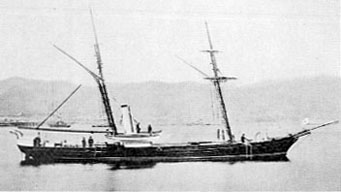
This gunboat was was brig-rigged, third class, made in wood. She was the first warship to be built in Japan. She was taken over, from the Shogun, by the Imperial Navy in May 1868, and was captured by the Shogunate forces during the civil war on 4 October 1868. She was recaptured at Hakodate by the Imperial Navy after grounding. Ghiyodogata was removed from the effective fleet June 1869 and sold to a whaling company in January 1888. She was finally broken up in 1911. She was a 140 tons ship, 97 feets long (31.3 wl x 4.8 x 2m), with one shaft reciprocating HDA engine delivering an output of 60 ihp, allowing 5 knots. She was armed with a single 5.5 inch and two small guns, served by a crew of 35 sailors and officers.
Frigate Fujiyama (1863)
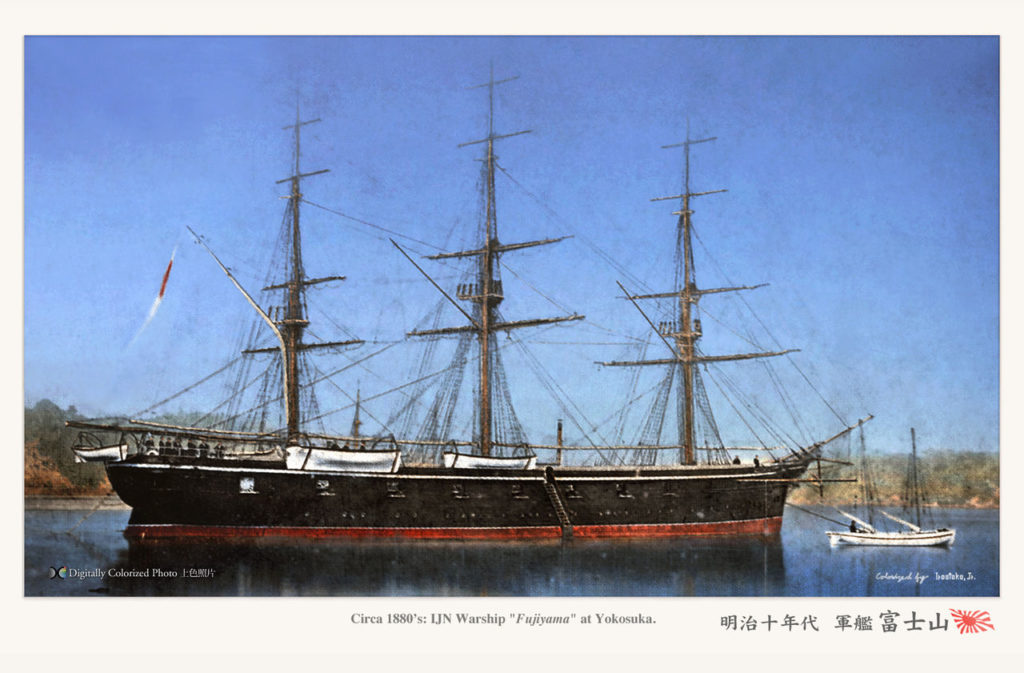
This wooden hull full rigged ships was built in New York. She was acquired by the Shogun in 1866, two years after launch, and commissioned as “Fuji Yama” into the Navy, earmed locally with one 6.5 in and two 6 in guns. She served actively until 1880 and was converted into a training ship, sold in 1896. She displaced 1000 tons, was 207 feets long at the waterline (63 x 1.03 x 3.27m), had a shaft mated do a reciprocating engine rated for 350 ihp, giving her 13 knots. Her original armament was lighter, one 6.3 in puzzle loading (160 mm) and two 5.9 in (150 mm) and ten small guns. Crew was 134.
Frigate Kasuga (1863)
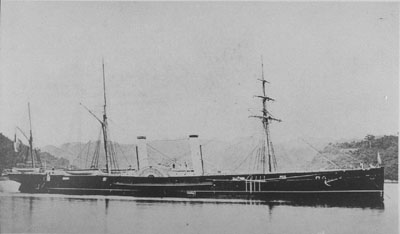
This full rigged, wooden-hull ship was purchased from China (1863 Chiangtzu) in 1867 by the Satsuma clan. She served as personal yacht for the Shogun, she served with the Imperial Navy in 1869 as a dispatch vessel. She displaced 1289 tons, was 248 feets 6 in long at the waterline (75.7 x 8.8 x 3.96m) was propelled was one shaft, HR engine rated for 1217 ihp and 9 knots. She was armed with a single 7.7 in (177 mm) gun and four 4.5 in (114 mm) plus two 30 pdr (90 mm) served by a crew of 138.
Frigate Kaiyō Maru (1865)
This particular ship was a composite hull, full rigged mixed ships built in the Netherlands, at C.Gips and Sons, Dordrecht, Netherlands, it was laid down in August 1863, launched on 3 November 1865, and Commissioned on 10 September 1866. Construction of what was then the largest wooden ship ever built in the Netherlands, was overseen by a Japanese military mission under Uchida Masao and Akamatsu Noriyoshi. In January 1868 Kaiyō Maru fought at the battle of Awa off Awaji Island. Along with Banryū Maru and Hazuru Maru she duelled against Satsuma Navy’s Kasuga Maru, Hōō Maru, and Heiun Maru. In late January 1868, she fled to Hokkaido, under Admiral Enomoto Takeaki carrying French military advisors including Jules Brunet. As part of the Hokkaido navy’s flagship of the Ezo Republic she was wrecked off Esashi during a storm in November 1868. She was rediscovered by a submarine in 1968, exactly one century after, her remains were gradually located and exhumated from the sea floot from 1974 to 1985. With all these elements, the ship was replicated in 1990 and is now located at Esashi, near the location of the original wreck.
Another actor of the Boshin war, this was Japanese first steam-powered warship, presented to the Tokugawa shogunate as a gift from King William III of the Netherlands. This was a gesture for head of the Netherlands Trading Society to established diplomatic relations opening of Japanese ports to Dutch commerce. This was a gunboat, wooden-hulled, Jackass-barque-rigged, with paddle wheels, displacing 781 t (769 long tons), and 66 m (216 ft 6 in) o/a in lenght for 9.1 m (29 ft 10 in) at the beam and a draught of 4.2 m (13 ft 9 in), propelled by a Coal-fired steam engine rated for 150 hp (110 kW) and armed with one 60 pdr muzzle-loading gun, two 30 pdr long barrel muzzle-loading gun, and one 30 pdr muzzle-loading gun. She became a training ship to the newly formed Nagasaki Naval Training Center, and later transferred to the new Tsukiji Naval Training Center in Edo in April 1857, and was later held by the Meiji government on 28 April 1868, on the Imperial side. She was part of the new IJN after the war, until 1876, whe she was retired and scrapped. Since the Dutch shipyard still possessed the original plans, Verolme Shipyards in the Netherlands replicated her in 1987, and is now a tourist ship, touring Japan from the Huis Ten Bosch theme park in Sasebo, Nagasaki.

CA’s Shogun II fall of the Samurai expansion is probably the only video game rendition of Japanese ships of the era.
Corvette Kanrin Maru (1855)

This particular ship, ordered in 1853 at the F.Smit, Kinderdijk yards in the Netherlands, was acquired in 1857 and became the first sail and screw-driven steam corvette of the Japanese Navy. It was presented to the shōgun’s government, the Bakufu, delivered on September 21, 1857 (named “Japan”), by Lt. Willem Huyssen van Kattendijke of the Dutch navy and used at the Naval School of Nagasaki to familiarize Japanese students with Western warship technology. Screw-driven steam warships were relatively new in the West as it was first introduced by HMS Rattler (1843), and previously the civilian ship SS Archimedes. The ship was copy of the Dutch navy’s schooner-rig Bali built in 1856. First mission saw the Kanrin Maru sailing to the United States to show the Japanese has mustered western navigation techniques and ship tech, at San Francisco. This was an historical event, being the second official Japanese embassy to cross the Pacific Ocean after the San Juan bautista in 1614. The object of the embassy was to sign and ratify a new treaty of Friendship, Commerce, and Navigation. However at the fall of 1867 the Bakufu government was found at war with the Imperial Forces. The ship eventually took refuge with a fleet of eight surviving warships in the north of Japan under orders of Enomoto Takeaki (Republic of Edo), but was eventually lost in a typhoon, and finished off by Imperial artillery and captured. Now part of the new IJN, she was lost a second time in a typhoon, this time fatally in 1871, at Esashi.
Corvette Kaiten (1851)
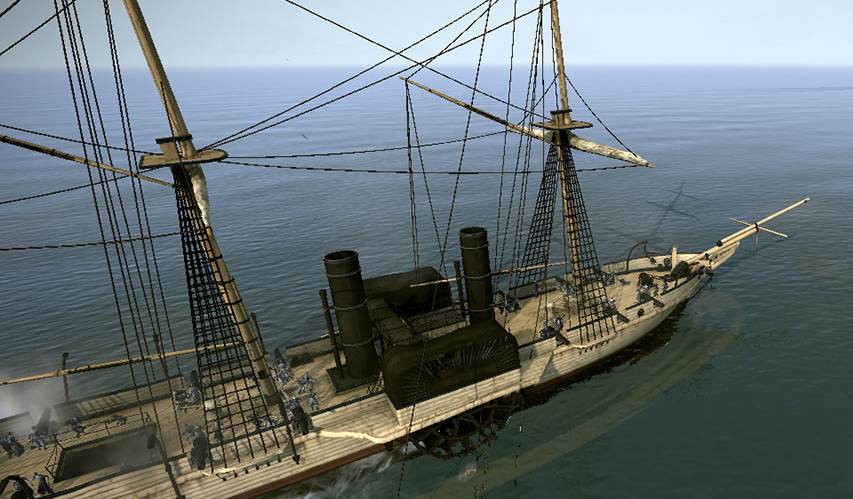
This particualt ship had a double life: First she was SMS Danzig, first steam-powered warship of the Prussian Navy, involved in the Battle of Tres Forcas in 1856, a punitive expedition against Riffian pirates. She was later decommissioned from the Prussian Navy because if dry rot hull damage in 1862, and reformed as paddle steamers were now obsolete. Sold to the English firm Dorset and Blythe for 56,000 taler, she found a new customer: The Japanese Tokugawa shogunate, renamed Kaiten (回天) from 1864. She was rearmed with 13 cannons, and participated in the Boshin War by forces loyal to the shōgun and became a key actor in the Naval Battle of Miyako Bay. She tried to to board and overtake the Kōtetsu, but forced to flee and becale later the flagship of the Ezo navy, in the Battle of Hakodate Bay. She survived some time but was beached at Aomori Bay near Hakodate on 6 May 1869 and burned by her crew on 20 Juneto prevent capture.
Corvette Chōyō Maru (1856)
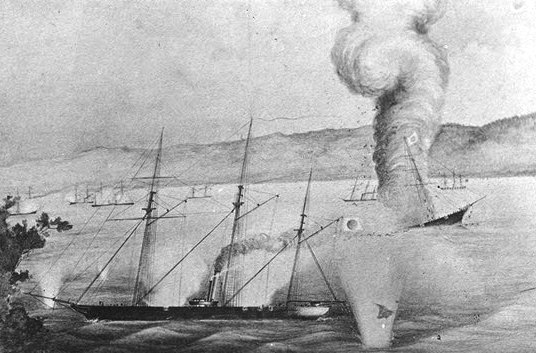
The sinking of the Chōyō Maru in May 1869 by Ezo paddle schooner Banryū.
The Tokugawa shogunate isolatiin policy was only broken by limited foreign trade with the Dutch and the Chinese and exclusively at Nagasaki under strict state control. No foreigners were allowed to set foot in Japan while no travel ws allowed for Japanese. However by 1844, King William II of the Netherlands urged the Shogun to end the policy before the contry was forced to do so. Which happened after the visit of Commodore Perry in 1853. To the intense debate that erupted within the Japanese government on how to handle this event the consensus that emerged was to bolster Japan’s coastal defenses. Many feudal domains took immediate steps to construct or purchase warships and out the few reverse-engineered, old designs that were available, obsolete by the time of their completion the Tokugawa shogunate issued an order to the Dutch for two new warships. The first was the Kanrin-Maru (see above) and the second vessel was Yedo, later renamed Chōyō Maru.
This was a three-masted wooden-hulled corvette rigged as a schooner and fitted with an auxiliary one-cylinder coal-fired 100 ihp (75 kW) reciprocating steam engine and two screws. She was 49 metres (160 ft 9 in) long overall and displaced 600 tons and was armed by twelve muzzle-loading cannon. Based on HNS Bali she was built at the C. Gips & Sons shipyard at Dordrecht. She arrived at Nagasaki in May 1858, renamed, assigned as a training ship and the Naval Training Center under supervision of H. van Kattendijke, but it was closed in 1859. The ship was then transferred to the new Tsukiji Naval Training Center in Edo. In 1862, she participated in a colonization expedition to the Ogasawara Islands and next year, the First Chōshū expedition, but was captured on the process. In 1864 she quelled the pro-sonnō jōi forces (Mito Rebellion) and later with the Imperial Japanese Navy she took part in the Boshin War, and sent north to Ezo (Hokkaido), fought at Hakodate, engaged Kaiten Maru and other ships and fired over 40 shots. In May she was engaged by the paddle schooner Banryū and one luck hit caused a massive explosion and she sank wirh nearly all hands.
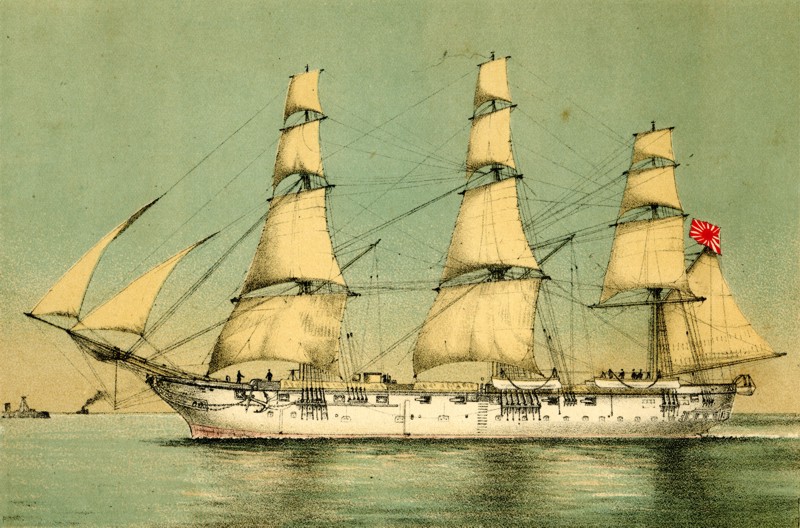
This wooden screw corvette was the British ex-Malacca acquired in 1870 and rearmed in 1892 with modern 6 in QF breech-loading rifled guns. The was built at Moulmain, in Burma, 1947 tons for 192 feets long (58.6 x 10.6 x 5.48 m), had a single reciprocating engine and 526 ihp for 10 knots, armed originally with six 4.5 in, two 30 pdr and two 24 pdr guns. She was scrapped in 1906.
Paddle Frigate Banryū (1956)
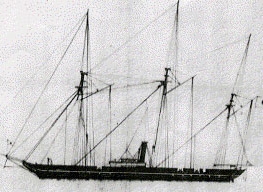
A british-built ship, at R & H Green of Blackwall, this iron paddle schooner named “Emperor” and presented to the Tokugawa Shogunate by the 8th Earl of Elgin as a present from Queen Victoria, completed as a royal yacht, with luxuriously furnished interiors, with sculptures and mirrors. She articipated in the Naval Battle of Awa, 28 January 1868, and served with Tokugawa loyalists and carried the Shogun Tokugawa Yoshinobu from Edo to exile. She served under the Republic of Ezo during the Boshin War in Japan after being seized by Enomoto Takeaki. This iron screw yacht was 41.8 metres long by 5.45 metres, and 3.23 metres of draught for a displacement of 370 tons and was armed by four 12-pounder bronze cannons. She als served at the Naval Battle of Miyako Bay in March 1869. During Battle of Hakodate Bay she sank the Imperial steam corvette Chōyō Maru but at theend of the battle, severely damaged and her ammunitions exhausted, she was beached near Benten Daiba and set on fire. After repairs and rebuilding in Shanghai she was renamed the SS Emperor, returned to Japan in 1873 as Raiden Maru and was eventually purchased by the Imperial Japanese Navy in 1877 as Raiden, used as a training vessel until 1888 but served later as awhaling ship out of Kochi, and other onwers until 1897.
Steamer Mikaho (1862)
Mikaho (美嘉保) was as small steamer warship used by the Bakufu (Shogunate) Navy around 1860. Enomoto Takeaki, vice-commander of the Navy, refused to cede his fleet to the new Imperial government and sailed for Shinagawa in August 1868, with Kaiyō, Kaiten, Banryū, Chiyodagata and four steam transports, among which the Kanrin, Mikaho, Shinsoku, Chōgei, many members of the Navy, members of the “Yugekitai” officials of the former Bakufu government and members of the French Military Mission but later encountered a typhoon off Choshi. The Mikaho was lost and Kanrin badly damaged.
Gunboat Un’yō (1868)
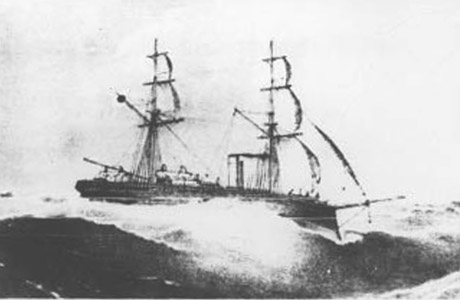
This iron-plated, wooden-hulled mixed gunboat served with the Imperial Japanese Navy. Rigged as a two-masted brig with a auxiliary coal-fired steam engine, she was ordered by the Chōshū Domain in 1868 and built by A. Hall & Co., Aberdeen, Scotland. In February 1870 sehe arrived and was commissioned as the Un’yō Maru. On July 25, 1871 however she was transferred to the Meiji government Imperial Japanese Navy, as Un’yo. She sailed to Kyūshū in 1874 and helped quell the Saga Rebellion. Next year she carried diplomats to Busan in Korea and returned later in 1875 under Inoue Yoshika to provoke a military response, the Ganghwa Island incident opning the Peninsula to Japanese trade. Next year she assisted the suppression of the Hagi Rebellion of disaffected former samurai. She later ran aground off the coast of the Kii Peninsula, and was scrapped.
Paddle steamer Chōgei Maru (1956)
Little information is available over this paddle steamer built in England, composite hull, brick-rigged, used for transportation, carrying troops faithful to the shōgun during the Boshin War. After the end of the Boshin War, she was used to transport wounded rebels to Tokyo.
Composite Gunboat Shinsoku (1956)
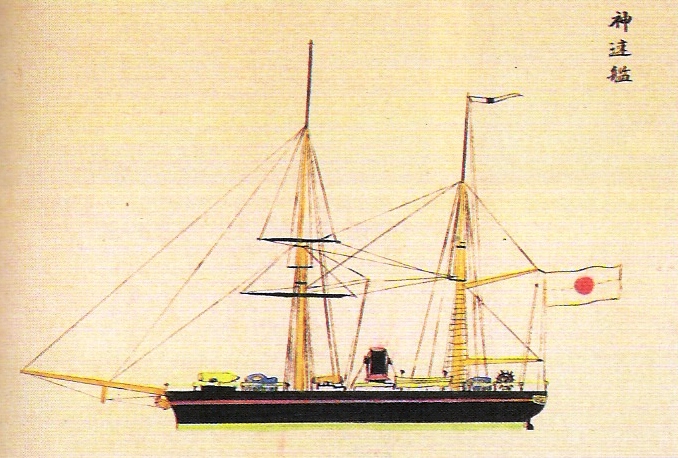
A composite hulled ship, rigged as a schooner, built in the USA and called SS meteor, she was used as a steam transport during the Boshin War on the Shogunate side. Enomoto Takeaki was vice-commander of the Shogunate Navy. During the Battle of Hakodate, she was fought on the Shogunate side and later tried to assist the Kaiyō Maru off the coast of Esashi, but she also capsized and sank in the process.
Armoured corvette Ryūjō (1869)
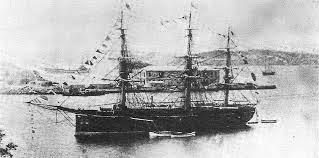
This broadside armoured corvette was built as a private venture, speculative offer by Aberdeen (Scotland) during the Boshin war. First idea was probably to deliver the ship to the Confederacy, but this of course never happened. Placed into the open market, the ship was bought by Prince Hizen in 1869, loaned to the Emperor. This composite hull 1500 tons ship was completed in march 1869 and apparently served during the war, and was returned to the Prince, and then integrated into the new IJN in 1870. She underwent a refit and at that time, Japan purchased many Krupp guns. She received therefore a single 6 in and five 6.3 in breech-loading guns. She served until 1898 and was mothballed and finally scrapped in 1904.
The Ryujo was 1429 tons, 213 feets (65 pp x 10.5 x 5.3 m), with one a shaft reciprocating 800 ihp giving her 9 knots and carried 350 tons of coal. She was served by a crew of 274 sailors and officers.
Corvette Nisshin (1869)
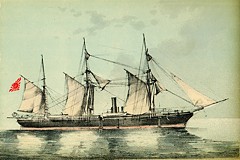
This barque-rigged wooden hull ship was ordered at Cornelisz Gips & Sons, Dordrecht (Netherlands) during the war but not completed until after the Shogunate forces were defeated and was acquired by the Hizen clan. She joined the Imperial Navy in May 1870, and her original guns were replaced by Krupp breech-loading rifled models, six 4.7 in guns. She was removed from the active fleet in 30 May 1892 and scrapped a year after. She was 1490 tons, 203 feets long between parallels (61.8 x 8.76 x 4.2 m), with one shaft mated to a reciprocating engine rated for 710 ihp, 11 knots, and originally armed with Armstrong guns, a single 7.7 in and six 30 pdr served by a crew of 145.
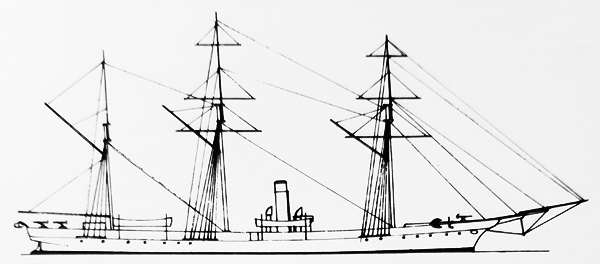
Blueprint of the Nisshin (Conways)
Gunboat Moshun (1865)
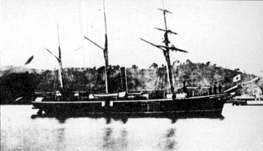
The third class, composite, schooner-rigged gunboat Moshun was originally completed in 1867 as the steamer Eugenie. She was sold to the Hizen clan in February 1868 and taken over by the Imperial Navy in July 1869 for service in the civil war. She was presented to the navy by the clan in 1870, and hulked in 1887.
305 tons, 143 feets long (43.5/45.7 oa x 6.7 x 2.36 m), one shaft reciprocating HDA engine, rated for 120 hp, 10 knots, armed with one 7.7 in gun and two small guns, served by a crew of 88 officers and sailors.
Teibo class gunboats (1866)
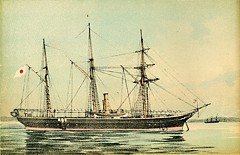
These two third class, wooden gunboats were originally built for mercantile purposes. Dai Ichi Teibo had been completed in 1867 as the SS Hinda and the other also completed in 1867, was the SS Assunta. They were purchased by the Choshu clan in 1868 and renamed Teibo Maru No 1 and Teibo Maru No 2 respectively. Teibo Maru No 1 was lent to the Imperial Navy early in 1868 and armed for use in the civil war. In July she was returned to her owners but both vessels were given to the Imperial Navy as gifts in 1870, and renamed Dai Ichi Teibo and Dai Ni Teibo. Dai Ichi Teibo was used as a survey vessel from 1873 until she was wrecked in the Kurile Islands in 1875. Dai Ni Teibo was removed from the operational fleet in 1885 and wrecked at Anori Point, Shimane Ken, on 2 April 1885.
These London-built barque-rigged third class gunboats were 236 tons ships, 125 feets long overall (38 oa x 6.4 x 2.28 m), one shaft reciprocating DA engine, 60 ihp for 10 knots, amred with one 5.9 and one 5.5 in (Dai ichi Teibo) or two 6.5 in BLR and two small guns (Dai Ni Teibo).
The Japanese Imperial Navy of the 1870s)
Before the 1894 war, which was mostly a test of the “Jeune Ecole” influence advocating using armoured cruisers and torpedo boats and showing that nothing was more worthy of classic hardcore battleships, the Japanese Navy had a composite fleet of older, 1870s rigged ships, including the central battery ironclad Fuso and armoured corvettes. These are not very well known ships, and that’s why they are seen there.
Fuso, central battery ironclad (1877)
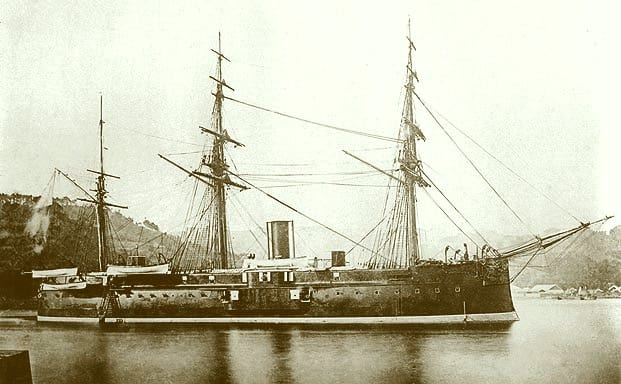
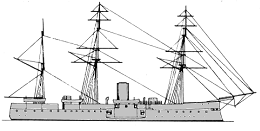
Blueprint (Conways)
The Fuso was laid down in September 1875 part of an ambitious program that prepared a war between Japan and Korea. The deign was ordered to Sir Edward Reed as a smaller Iron Duke. She was barque-rigged equipped with machinery from penn and Sons of Greenwhich. These were two pairs of CHSCT engines for a radius of 400 nm, at 10 knots. However the guns were from Krupp in germany and the layout was inspired by the French Redoutable class. Launched in march 1877 at Samuda Bros., poplar, the Fuso was completed in 1878. In 1894, just before the war with China, she was taken in hand for a complete overhaul. The mainmasts were removed, military masts fitted instead, te old 6 in/50 QF guns were replaced by a 6.7 in and two 6 in/50, one on the front deck and one on the rear deck. This was completed by eleven 3 pdr QF guns, and two above water 18 in (457 mm) TTs. Present at the battle of Yalu, Fuso was damaged but was repaired. She collided three years after with the Matsushima and ran aground on Shikoku Island. After extensive repairs and a new refit at Kure in 1898-99 where she received 6 in guns to replace her old 9.4 in ones, she had some extra 3-Pdr added; She was reclassified as a coast defence ship and managed to survived until 1908, discarded and broken up in 1910.
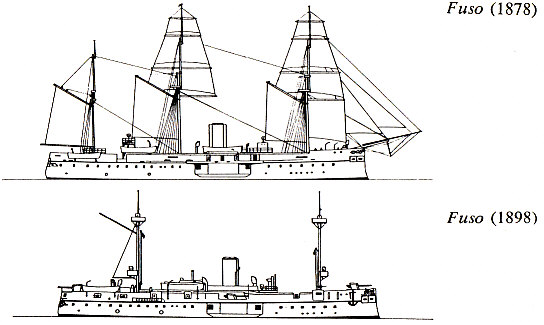
Evolution of the Fuso 1878-1894.
Kongo class armoured corvettes (1877)
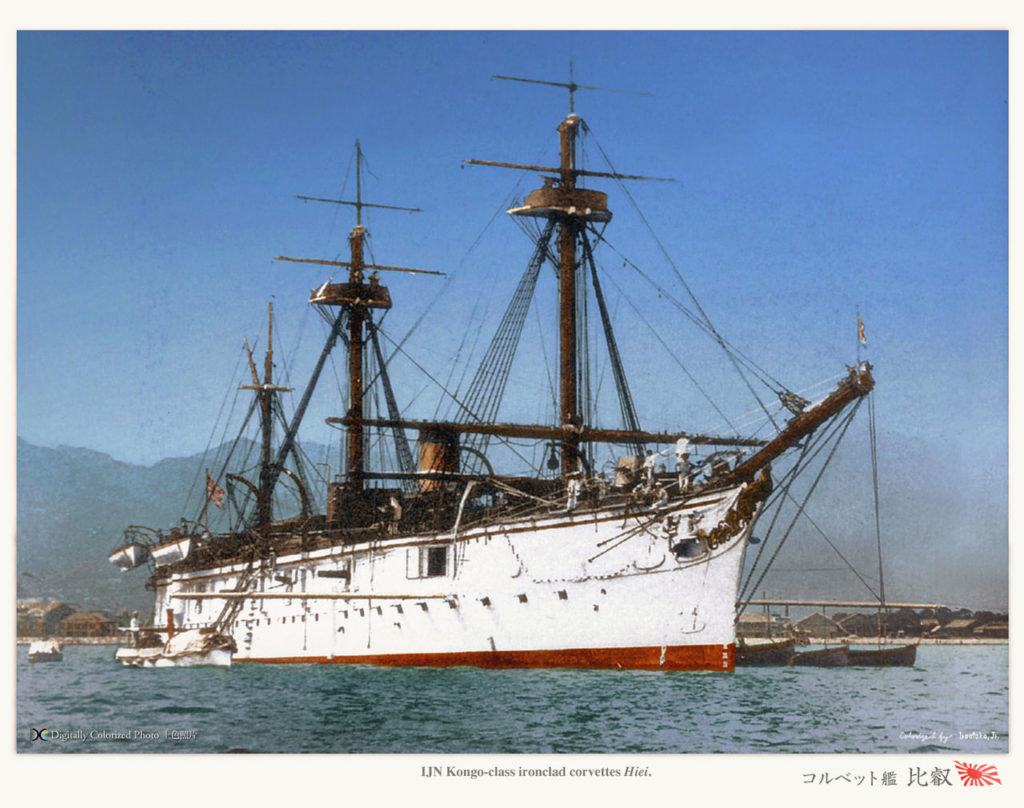
Design of these ships was prepared by Sir Edward Reed, based on the Russian cruiser General Admiral. They also ahd some influence from the British Gem class cruisers. These were composite-hull, for the Kongo and iron hull for the Hiei, built respectively at Earle’s Sb Co, Hull and Milford Haven Sb co. Pembroke. Launched in April 1877 and June 1877, they were completed in January and March 1878. These 2200 tons ships were capable of a 3100 nautica Miles radius at 10 knots. A first 1895 refit saw their top masts removed and replaced by military masts. In addition an extra 1 pdr gun was added and in 1903 two 3 in, two 2-1/2 Pdr and six MGs. Hiei fought at the battle of Yalu, severely damaged by the Chinese battleships. The Kongo was involved in the Hawaiian revolution of 1898. Both ships were removed afterwards from service, used as survey vessels. Hiei was discarded in 1911 and Kongo in 1909.
Corvette Asama (1869)
The composute hull Asama was purchased from France in 1874 and relegated to training in 1887, removed from the list in 1887 but served as a torpedo school ship at Yokosuka. She was 1442 tons, 228 feets long (69.72 x 8.76 x 4.26m) and has a single reciprocating shaft HC, for 300 ihp and 11 knots. She was armed with eiht 6.7 in and four 4.5 in guns.
Screw sloop Seiki (1875)
Seiki was a barque-rigged, wooden hulled sip, first to be built at Yokosuka NyD, managed by French engineers, and construction was supervized by engineer Verny and his staff. The ship had a single shaft reciprocating HCRA engine ablt to give 443 ihp for 9.5 knots. She was 897 tonnes, 203 feets long (60.96 x 9.14 x 3.96 m), armed with a single 5.9 in (150 mm), a 4.7 in (120 mm), a 6-pdr (55 mm) Krupp guns and three 4-barrelled Nordenfelt machine guns. Crew was 167. She was the first Japanese warhip to visit the British Isles, but was later grounded in the Fuji river off Suruya Wan, a constructive total loss in December 1888.
Screw sloop Amagi (1877)
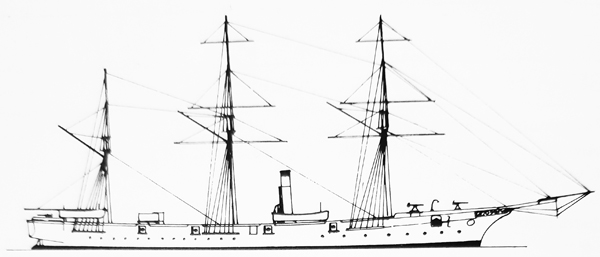
This wooden-hulled ships was slightly larger and more heavily armed version of the Seiki, both built at the same Yard, mounting identical machinery, but power was almost doubled n Amagi, from 430 to 720 ihp to give an extra 2 knots. She was armaed with Krupp guns, with a 6.7 in (170 mm), four 4.7 in (120 mm), thre 12-dpr, and three Nordenfelt MGs, reclassed as a gunboat in 1898 and sold for scrap just before before the Russo-Japanese war.
Paddle corvette Jingei (1876)
This wooden-hull paddle corvette took nine years to complete at Yokosuka NyD, and it may have been the result of result of problems arising with the installation of her machinery. She served as an Imperial yacht before being relegated to the role of training ship in 1894.
Kaimon class corvettes (1882)
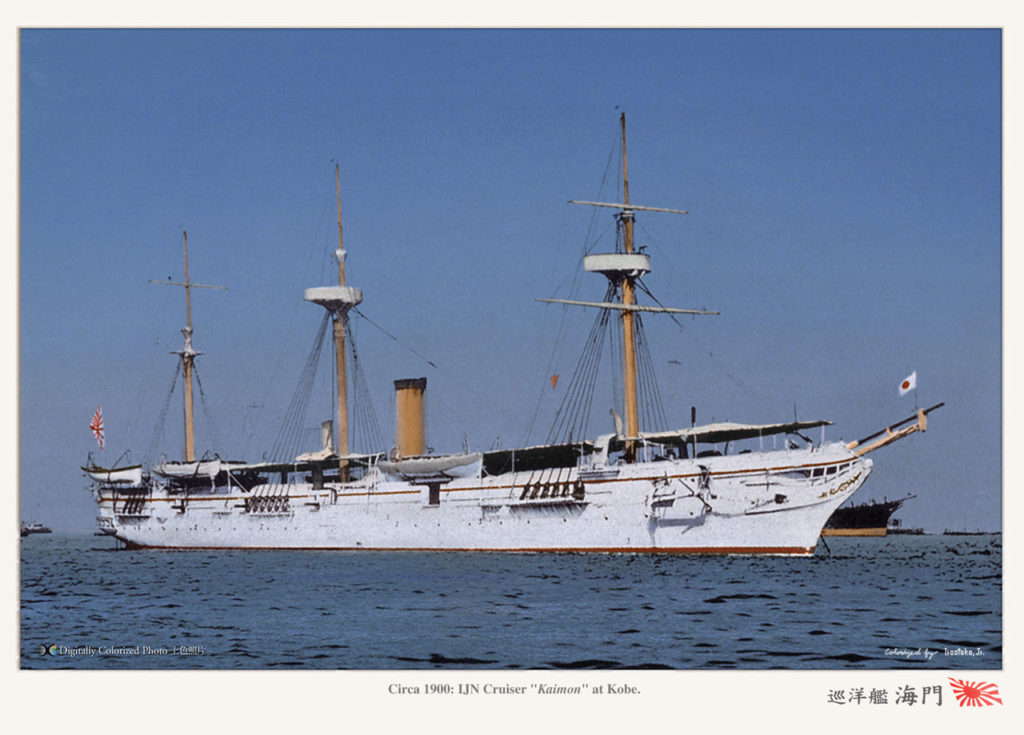
These barque-rigged corvettes were the most effective of the smaller types of warship in service in the Japanese Navy towards the end of the 19th Century. They were built under French supervision an completed with Krupp armament at Yokosuka NyD, both later were refitted, a new bow replacing the original graceful knee stem, and military masts replacing the fore and main masts. The ships carried out a number of operations during the Russo-Japanese war, the Kaimon being lost off Talien Wan Bay in July 1904 when strucking a mine. Tenryu survived the war and was finally removed from service in 1906.
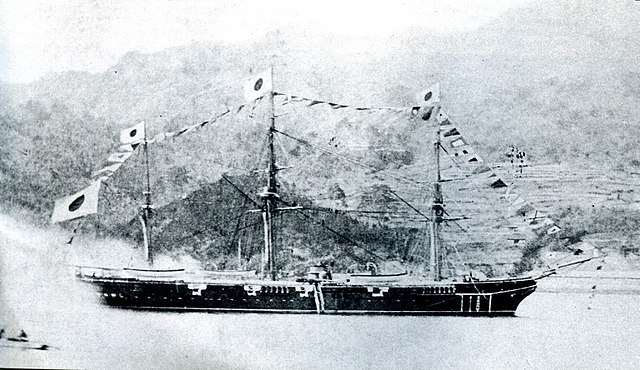
gunboat Hosho (1868)
The composite-built gunboat Hosho (launched 1868, completed 1869) was fully-rigged, built at A Hall & Co, Aberdeen, purchased in 1872. She was 316 tons, 144 feets long (43.9 m pp, 6.7 m wide, 2.05 m draught). She carried a single shaft reciprocating HDA engine rated for 240hp, giving 11 knots with 110 tons of coal. She was armed with a single 7.7 inch and a 5.5 inch gun.
This small, wooden-hulled gunboat was built at Yokosuka NyD, laid down in February 1877, launched in July 1878 and completed in August 1880. She was active during the 1894 and 1906 wars, but discarded before 1913. She had a prominent poop. A small 656 tons ship, she was 154 feets long (46.9 x 7.88 x 3.9 m) and had a single recopcrocating HC engine, rated for 590 hp, which provided her 10.1/2 knots, and carried 107 tons of coal. She was armed with one 5.9 in gun, one 7.7 in, two 12-pdr, and three 4-barreled Nodenfelt machine guns.
Gunboat Raiden (1856)
This Blackwall-built gunboat was launched in 1856. She was a paddle yacht (armed) of the Shogun. Formerly HMS Emperor, presented to the Shogun and accepted as a good will present by Queen Victoria back in 1856. This barquentine-rigged ship was renamed Banryu first, but was eventually acquired by the Imperial forces in 1868. In april she deserted for the Shogunate forces and after the war, was sold to an American commercial company. She was re-purchased by the Emperor in 1873 and commissionned as the Raiden in 1877. She was sold and broken up in 1888. She displaced 400 tons, was 135 feets long (41.15 x 6.7 x 2.6 m), had one shaft reciprocating HDA engine rated for 600 hp, giving her a top speed of 9 knots. Her only armament comprised four old muzzle loading guns. It is not known if she was rearmed afterwards.
Maya class gunboats (1885)
These four schooner-rigged vessels were ordered under the 1882 Programme, the first two having iron hulls (Onohama Kobe, Ishikawajima Tokyo), the third a combination of iron and steel (Yokosuka NyD), and the fourth an all steel hull (Onohama, Kobe). The Akagi was distinguished from the other ships by having a raised foc’s’le. The ships were later re-armed, the Chokai and Maya having two 5.9in guns, which on the Maya were again altered to four 4.7in in 1906. The other two vessels were both given four 4.7in QF. Maya and Chokai were scrapped in 1913-1914, Akagi sold in 1912 but Atago was sunk on 6.11.1904.
Oshima (1891):
The Oshima (started 1889, launched 1891) was notable for being the first ship to be equipped with Japanese built VTE machinery. The steel-hulled vessel showed strong French influence in her design, with pronounced ram, and the guns being sited on the foc’s’le and poop and on sponsons amidships. She was a 630 ton ship, 175 feets long (53.5 x 8 x 2.75m), with two shafts reciprocating VTE engines, rated for 1200 ihp enough for 16 knots. She was armed with four 4.7 in guns and fove 3-pdr QF guns, served by a crew of 130.
Read More:
List of Meiji era ships
List of IJN ships
Conway’s all the world fighting ships 1860 -1905

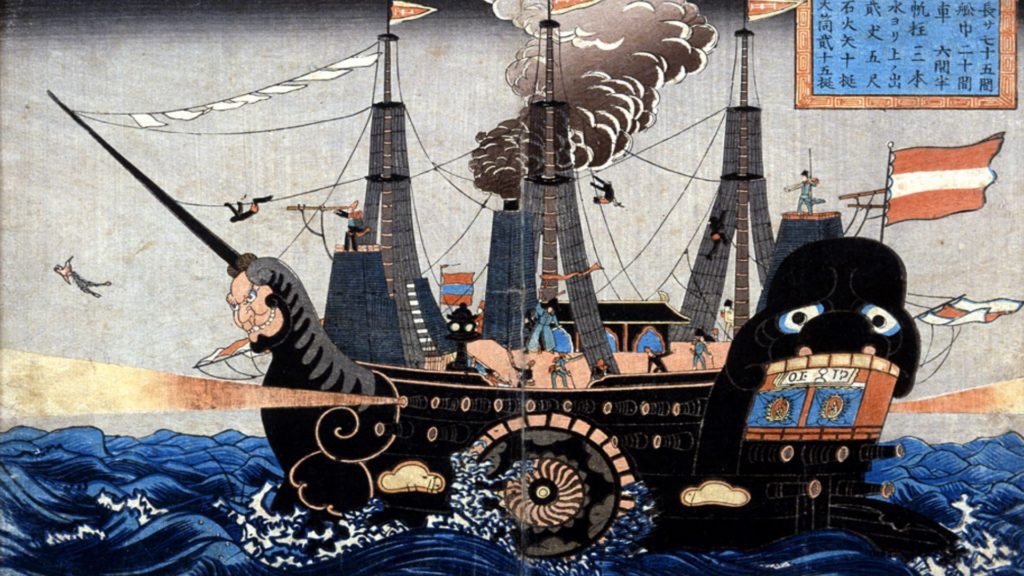
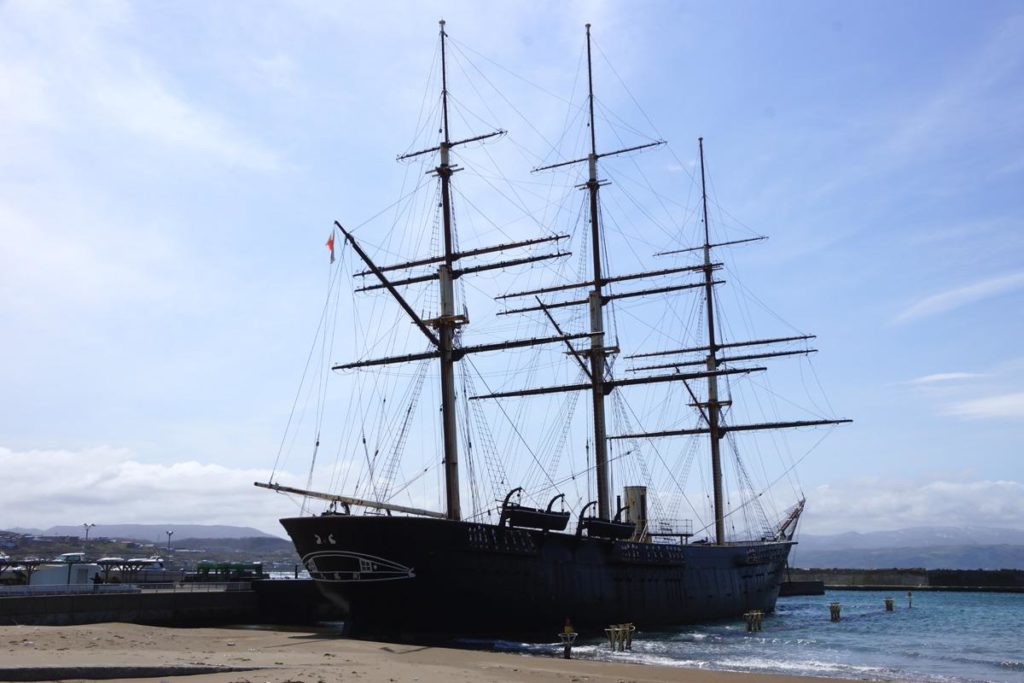

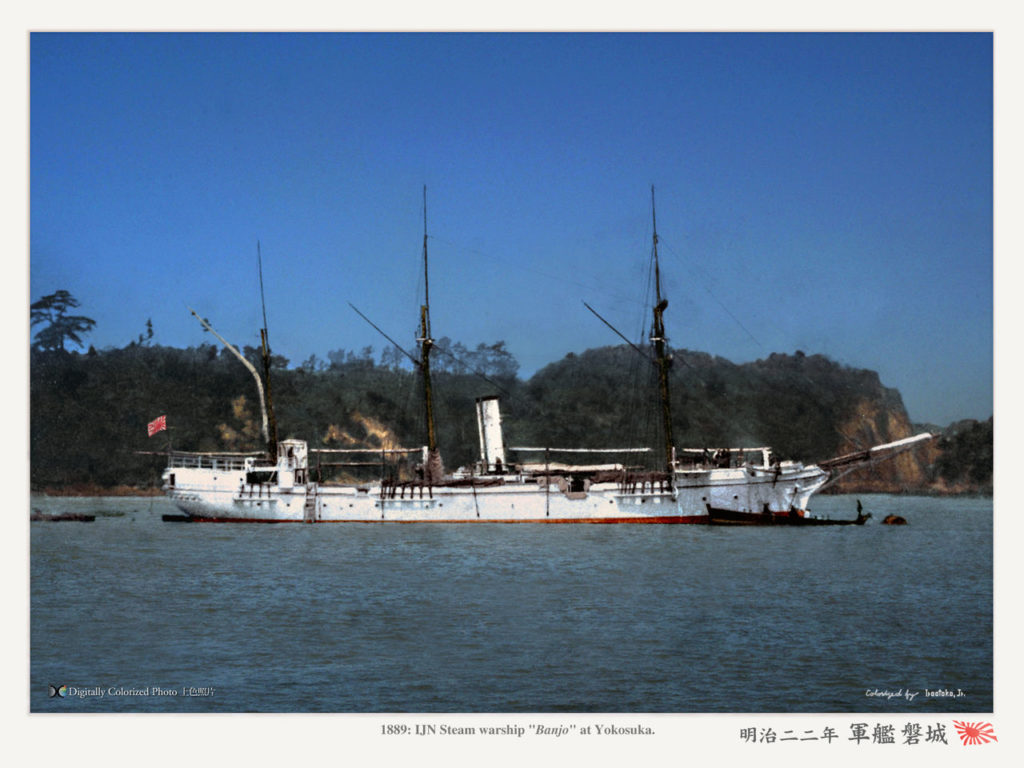
 Latest Facebook Entry -
Latest Facebook Entry -  X(Tweeter) Naval Encyclopedia's deck archive
X(Tweeter) Naval Encyclopedia's deck archive Instagram (@navalencyc)
Instagram (@navalencyc)





 French Navy
French Navy Royal Navy
Royal Navy Russian Navy
Russian Navy Armada Espanola
Armada Espanola Austrian Navy
Austrian Navy K.u.K. Kriegsmarine
K.u.K. Kriegsmarine Dansk Marine
Dansk Marine Nautiko Hellenon
Nautiko Hellenon Koninklije Marine 1870
Koninklije Marine 1870 Marinha do Brasil
Marinha do Brasil Osmanlı Donanması
Osmanlı Donanması Marina Do Peru
Marina Do Peru Marinha do Portugal
Marinha do Portugal Regia Marina 1870
Regia Marina 1870 Nihhon Kaigun 1870
Nihhon Kaigun 1870 Preußische Marine 1870
Preußische Marine 1870 Russkiy Flot 1870
Russkiy Flot 1870 Svenska marinen
Svenska marinen Søværnet
Søværnet Union Navy
Union Navy Confederate Navy
Confederate Navy Armada de Argentina
Armada de Argentina Imperial Chinese Navy
Imperial Chinese Navy Marinha do Portugal
Marinha do Portugal Mexico
Mexico Kaiserliche Marine
Kaiserliche Marine 1898 US Navy
1898 US Navy Sovietskiy Flot
Sovietskiy Flot Royal Canadian Navy
Royal Canadian Navy Royal Australian Navy
Royal Australian Navy RNZN Fleet
RNZN Fleet Chinese Navy 1937
Chinese Navy 1937 Kriegsmarine
Kriegsmarine Chilean Navy
Chilean Navy Danish Navy
Danish Navy Finnish Navy
Finnish Navy Hellenic Navy
Hellenic Navy Polish Navy
Polish Navy Romanian Navy
Romanian Navy Turkish Navy
Turkish Navy Royal Yugoslav Navy
Royal Yugoslav Navy Royal Thai Navy
Royal Thai Navy Minor Navies
Minor Navies Albania
Albania Austria
Austria Belgium
Belgium Columbia
Columbia Costa Rica
Costa Rica Cuba
Cuba Czechoslovakia
Czechoslovakia Dominican Republic
Dominican Republic Haiti
Haiti Hungary
Hungary Honduras
Honduras Estonia
Estonia Iceland
Iceland Eire
Eire Equador
Equador Iran
Iran Iraq
Iraq Latvia
Latvia Liberia
Liberia Lithuania
Lithuania Mandchukuo
Mandchukuo Morocco
Morocco Nicaragua
Nicaragua Persia
Persia San Salvador
San Salvador Sarawak
Sarawak Uruguay
Uruguay Venezuela
Venezuela Zanzibar
Zanzibar Warsaw Pact Navies
Warsaw Pact Navies Bulgaria
Bulgaria Hungary
Hungary

 Bundesmarine
Bundesmarine Dutch Navy
Dutch Navy Hellenic Navy
Hellenic Navy Marina Militare
Marina Militare Yugoslav Navy
Yugoslav Navy Chinese Navy
Chinese Navy Indian Navy
Indian Navy Indonesian Navy
Indonesian Navy JMSDF
JMSDF North Korean Navy
North Korean Navy Pakistani Navy
Pakistani Navy Philippines Navy
Philippines Navy ROKN
ROKN Rep. of Singapore Navy
Rep. of Singapore Navy Taiwanese Navy
Taiwanese Navy IDF Navy
IDF Navy Saudi Navy
Saudi Navy Royal New Zealand Navy
Royal New Zealand Navy Egyptian Navy
Egyptian Navy South African Navy
South African Navy






























 Ukrainian Navy
Ukrainian Navy dbodesign
dbodesign